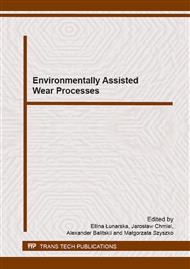[1]
M. Herwig, Fatigue damage of low amplitude cycles in low carbon steel, J Mater Sci 44 (18) (2009) 4919-4929.
DOI: 10.1007/s10853-009-3751-x
Google Scholar
[2]
V.F. Terentev, On the problem of the fatigue limit of metallic materials, Metal Science and Heat Treatment 46 (5-6) (2004) 244-249.
Google Scholar
[3]
Ł. Kaczmarek, K. Kyzioł, J. Sawicki, M. Stegliński, H. Radziszewska, W. Szymański, Ł. Kołodziejczyk, R. Atraszkiewicz, D. Kottfer, P. Zawadzki, The influence of chemical groups on the mechanical properties of sicnh coatings deposited on 7075 aluminum alloy, Thin Solid Films 534 (2013).
DOI: 10.1016/j.tsf.2013.01.055
Google Scholar
[4]
Ł. Kaczmarek, P. Kula, J. Sawicki, S. Armand, T. Castro, B. Kruszyński, A. Rochel, New possibilities of applications aluminum alloys in transport, Archives of Metallurgy and Materials 54 (4) (2009) 1199-1207.
Google Scholar
[5]
W. Gräfen, B. Edenhofer, New developments in thermo-chemical diffusion processes, Surface & Coatings Technology 200 (2005) 1830–1836.
DOI: 10.1016/j.surfcoat.2005.08.107
Google Scholar
[6]
P. Kula, R. Pietrasik, K. Dybowski, Vacuum carburizing-process optimization, Journal of Materials Processing Technology 164-165 (2005) 876-881.
DOI: 10.1016/j.jmatprotec.2005.02.145
Google Scholar
[7]
S. Preisser, F. Seemann, R. Zenker, Vacuum carburizing with high pressure gas quenching – the application, In: 1st Int. Automotive Heat Treating Conf., Mexico (1998), 135-147.
Google Scholar
[8]
J. Sawicki, M. Górecki, Ł. Kaczmarek, Z. Gawroński, K. Dybowski, R. Pietrasik, W. Pawlak, Increasing the durability of pressure dies by modern surface treatment methods, Chiang Mai Journal of Science 40 (5) (2013) 886–897.
Google Scholar
[9]
Z. Gawroński, A. Malasiński, J. Sawicki, Elimination of galvanic copper plating process used in hardening of conventionally carburized gear wheels, International Journal of Automotive Technology 11 (2010) 127-131.
DOI: 10.1007/s12239-010-0017-1
Google Scholar
[10]
Z. Gawroński, B. Kruszyński, P. Kula, Synergistic effects of thermo-chemical treatment and super abrasive grinding in gears' manufacturing, Journal of Materials Processing Technology 159 (2) (2005) 249-256.
DOI: 10.1016/j.jmatprotec.2004.04.419
Google Scholar
[11]
P. Kula, J. Olejnik, P. Heilman P. European Patent EP1558780 (2007), U.S. Patent 7, 513, 958 (2009).
Google Scholar


